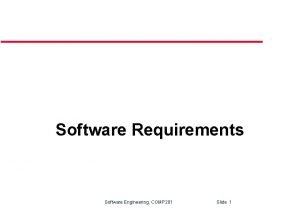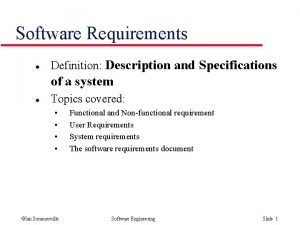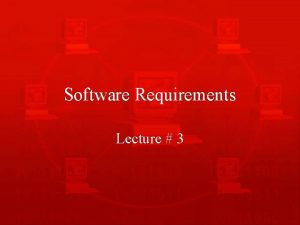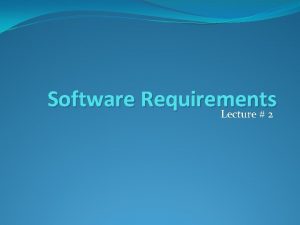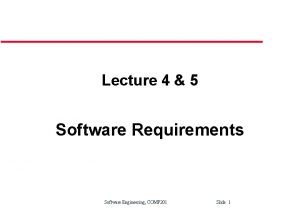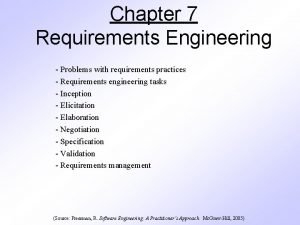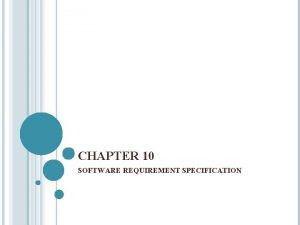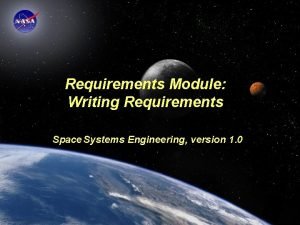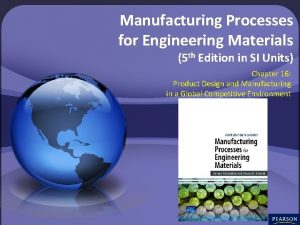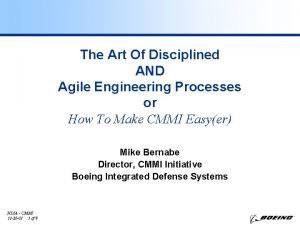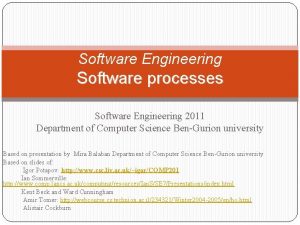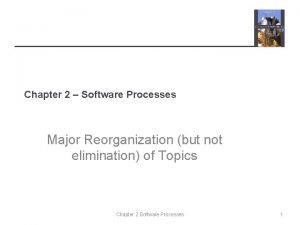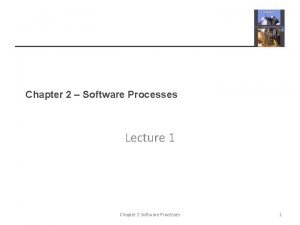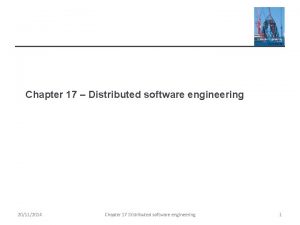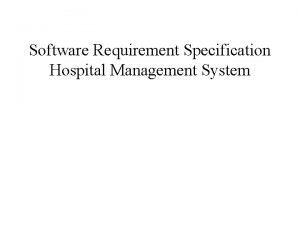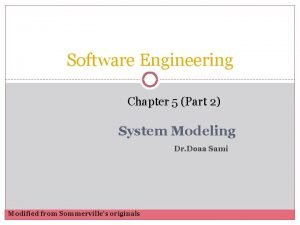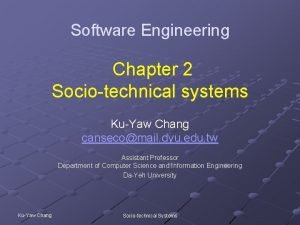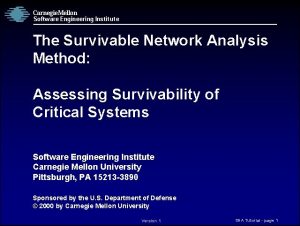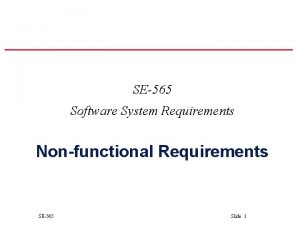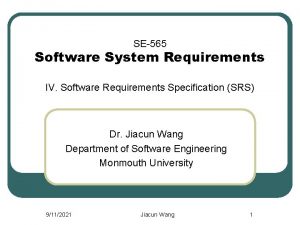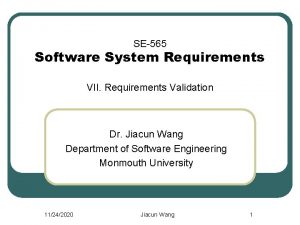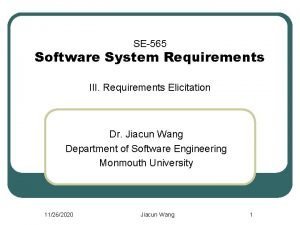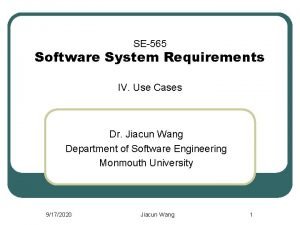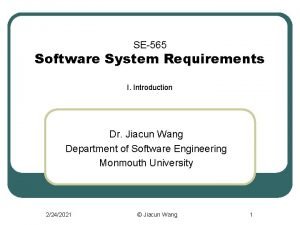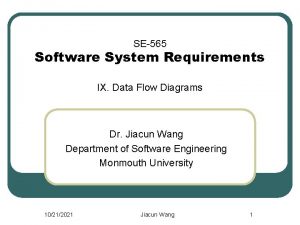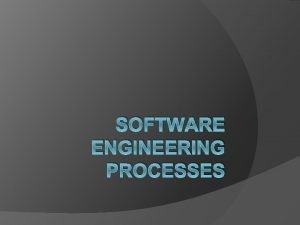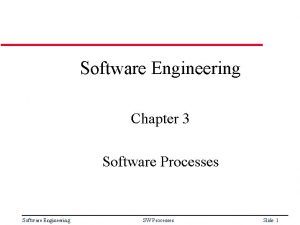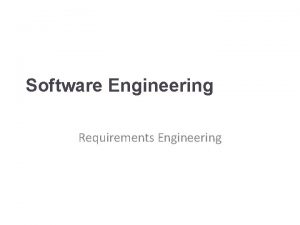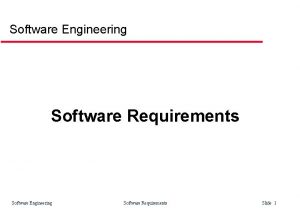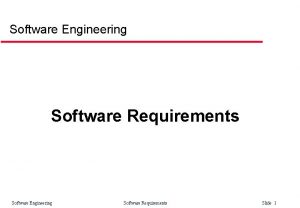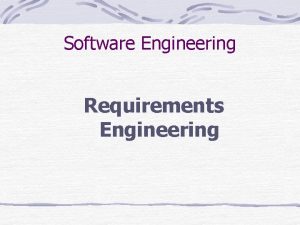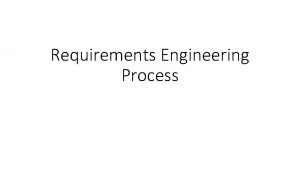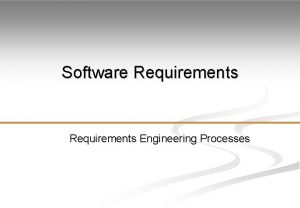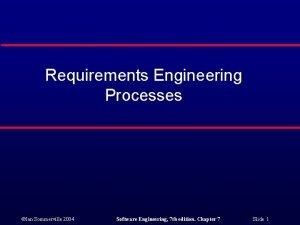SE565 Software System Requirements II Requirements Engineering Processes





































- Slides: 37

SE-565 Software System Requirements II. Requirements Engineering Processes Dr. Jiacun Wang Department of Software Engineering Monmouth University 10/24/2021 © Jiacun Wang 1

Objectives § To introduce the notion of processes and process models for requirements engineering § To explain the critical role of people in requirements engineering processes § To explain why process improvements is important and to suggest a process improvement model for requirements engineering 10/24/2021 © Jiacun Wang 2

Processes § A process is an organized set of activities which transforms inputs to outputs § Process descriptions encapsulate knowledge and allow it to be reused § Examples of process descriptions § Instruction manual for a dishwasher § Cookery book § Procedures manual for a bank § Quality manual for software development 10/24/2021 © Jiacun Wang 3

Design processes § Processes which involve creativity, interactions between a wide range of different people, engineering judgment and background knowledge and experience § Examples of design processes § § Writing a book Organizing a conference Designing a processor chip Requirements engineering 10/24/2021 © Jiacun Wang 4

RE process - inputs and outputs 10/24/2021 © Jiacun Wang 5

Input/output description 10/24/2021 © Jiacun Wang 6

RE process variability § RE processes vary radically from one organization to another § Factors contributing to this variability include § Technical maturity § Disciplinary involvement § Organizational culture § Application domain § There is therefore no ‘ideal’ requirements engineering process 10/24/2021 © Jiacun Wang 7

Process models § A process model is a simplified description of a process presented from a particular perspective § Types of process model include: § Coarse-grain activity models § Fine-grain activity models § Role-action models § Entity-relation models 10/24/2021 © Jiacun Wang 8

Coarse-grain activity model of RE 10/24/2021 © Jiacun Wang 9

RE process activities § Requirements elicitation § Requirements discovered through consultation with stakeholders § Requirements analysis and negotiation § Requirements are analyzed and conflicts resolved through negotiation § Requirements documentation § A requirements document is produced § Requirements validation § The requirements document is checked for consistency and completeness 10/24/2021 © Jiacun Wang 10

Waterfall model of the software process 10/24/2021 © Jiacun Wang 11

Context of the RE process 10/24/2021 © Jiacun Wang 12

Spiral model of the RE process 10/24/2021 © Jiacun Wang 13

Actors in the RE process § Actors in a process are the people involved in the execution of that process § Actors are normally identified by their roles rather than individually § Requirements engineering involves actors who are primarily interested in the problem to be solved (end-users, etc) as well actors interested in the solution (system designers, etc. ) § Role-action diagrams document which actors are involved in different activities 10/24/2021 © Jiacun Wang 14

RAD for software prototyping 10/24/2021 © Jiacun Wang 15

Role descriptions 10/24/2021 © Jiacun Wang 16

Human and social factors § Requirements engineering processes are dominated by human, social and organizational factors because they always involve a range of stakeholders from different backgrounds and with different individual and organizational goals. § System stakeholders may come from a range of technical and non-technical background and from different disciplines 10/24/2021 © Jiacun Wang 17

Types of stakeholder § Software engineers responsible for system development § System end-users who will use the system after it has been delivered § Managers of system end-users who are responsible for their work § External regulators who check that the system meets its legal requirements § Domain experts who give essential background information about the system application domain 10/24/2021 © Jiacun Wang 18

Factors influencing requirements § Personality and status of stakeholders § The personal goals of individuals within an organization § The degree of political influence of stakeholders within an organization 10/24/2021 © Jiacun Wang 19

Process support § CASE (Computer-Aided Software Engineering) tools provide automated support for software engineering processes § The most mature CASE tools support well-understood activities such as programming, testing and project management § Support for requirements engineering is still limited because of the informality and the variability of the process 10/24/2021 © Jiacun Wang 20

Two types of CASE tools for RE § Modeling and validation tools support the development of system models which can be used to specify the system and the checking of these models for completeness and consistency. § Management tools help manage a database of requirements and support the management of changes to these requirements. 10/24/2021 © Jiacun Wang 21

A requirements management system 10/24/2021 © Jiacun Wang 22

Requirements management tools § § § Requirements browser Requirements query system Traceability support system Report generator Requirements converter and word processor linker Change control system 10/24/2021 © Jiacun Wang 23

Process improvement § Process improvement is concerned with modifying processes in order to meet some improvement objectives § Improvement objectives § Quality improvement § Schedule reduction § Resource reduction 10/24/2021 © Jiacun Wang 24

Planning process improvement § What are the problems with current processes? § What are the improvement goals? § How can process improvement be introduced to achieve these goals? § How should process improvements be controlled and managed? 10/24/2021 © Jiacun Wang 25

RE process problems § § § Lack of stakeholder involvement Business needs not considered Lack of requirements management Lack of defined responsibilities Stakeholder communication problems Over-long schedules and poor quality requirements documents 10/24/2021 © Jiacun Wang 26

Process maturity § Process maturity can be thought of as the extent that an organization has defined its processes, actively controls these processes and provides systematic human and computerbased support for them. § The SEI’s Capability Maturity Model is a framework for assessing software process maturity in development organizations 10/24/2021 © Jiacun Wang 27

Capability maturity model 10/24/2021 © Jiacun Wang 28

Maturity levels § § § Initial level § Organizations have an undisciplined process and it is left to individuals how to manage the process and which development techniques to use. Repeatable level § Organizations have basic cost and schedule management procedures in place. They are likely to be able to make consistent budget and schedule predictions for projects in the same application area. Defined level § The software process for both management and engineering activities is documented, standardized and integrated into a standard software process for the organization. 10/24/2021 © Jiacun Wang 29

Maturity levels § Managed level § Detailed measurements of both process and product quality are collected and used to control the process. § Optimizing level § The organization has a continuous process improvement strategy, based on objective measurements, in place. 10/24/2021 © Jiacun Wang 30

RE process maturity model 10/24/2021 © Jiacun Wang 31

RE process maturity levels § Initial level § No defined RE process. Suffer from requirements problems such as requirements volatility, unsatisfied stakeholders and high rework costs. Dependent on individual skills and experience. § Repeatable level § Defined standards for requirements documents and policies and procedures for requirements management. § Defined level § Defined RE process based on good practices and techniques. Active process improvement process in place. 10/24/2021 © Jiacun Wang 32

Good practice for RE process improvement § RE processes can be improved by the systematic introduction of good requirements engineering practice § Each improvement cycle identifies good practice guidelines and works to introduce them in an organization 10/24/2021 © Jiacun Wang 33

Examples of good practice guidelines § § § § Define a standard document structure Uniquely identify each requirement Define policies for requirements management Use checklists for requirements analysis Use scenarios to elicit requirements Specify requirements quantitatively Use prototyping to animate requirements Reuse requirements 10/24/2021 © Jiacun Wang 34

Chapter review § The requirements engineering process is a structured set of activities which lead to the production of a requirements document. § Inputs to the requirements engineering process are information about existing systems, stakeholder needs, organizational standards, regulations and domain information. § Requirements engineering processes vary radically from one organization to another. § Most processes include requirements elicitation, requirements analysis and negotiation and requirements validation 10/24/2021 © Jiacun Wang 35

Chapter review § Requirements engineering process models are simplified process description which are presented from a particular perspective. § Human, social and organizational factors are important influences on requirements engineering processes. § Requirements engineering process improvement is difficult and is best tackled in an incremental way. § Requirements engineering processes can be classified according to their degree of maturity. 10/24/2021 © Jiacun Wang 36

Exercises § Explain why there is a great deal of variability in the requirements engineering processes used in different organizations? § Explain why both coarse-grain and fine-grain activity models of a process should be produced in an organization. § Explain why waterfall model of the software process is not an accurate reflection of the detailed software process in most organizations. Why is spiral model more realistic? § Why is it important to understand the roles of people involved in requirements engineering processes? § What factors are likely to be particularly significant when considering requirements engineering process improvement? 10/24/2021 © Jiacun Wang 37
 Comp 201
Comp 201 System requirements in software engineering
System requirements in software engineering Computer based system engineering
Computer based system engineering Concurrent in os
Concurrent in os Inverse requirements
Inverse requirements Inverse requirements
Inverse requirements High level requirements
High level requirements Requirements discovery techniques in software engineering
Requirements discovery techniques in software engineering Software requirement specification for atm system
Software requirement specification for atm system What is domain requirements in software engineering
What is domain requirements in software engineering What are functional requirements in software engineering
What are functional requirements in software engineering Seven distinct tasks to requirements engineering
Seven distinct tasks to requirements engineering Unambiguous requirements in software testing
Unambiguous requirements in software testing Source and sink model
Source and sink model Forward engineering in software engineering
Forward engineering in software engineering Requirements writing for system engineering
Requirements writing for system engineering Software maintenance process models ppt
Software maintenance process models ppt Frank maurer
Frank maurer What is software metrics in software engineering
What is software metrics in software engineering Software crisis in software engineering
Software crisis in software engineering Software metrics example
Software metrics example Real time software design in software engineering
Real time software design in software engineering Design principles in software engineering
Design principles in software engineering Manufacturing processes for engineering materials 5th
Manufacturing processes for engineering materials 5th Agile engineering processes
Agile engineering processes Software requirement and design
Software requirement and design Software processes
Software processes Software processes
Software processes Context models in software engineering
Context models in software engineering What is distributed system in software engineering
What is distributed system in software engineering Hospital management system er diagram
Hospital management system er diagram System modeling in software engineering
System modeling in software engineering Socio technical system in software engineering
Socio technical system in software engineering System survivability in software engineering
System survivability in software engineering Computer skills for preparatory programs
Computer skills for preparatory programs Is an os system software or application software
Is an os system software or application software A system has 12 magnetic tape drives and 3 processes
A system has 12 magnetic tape drives and 3 processes Non functional requirements
Non functional requirements
